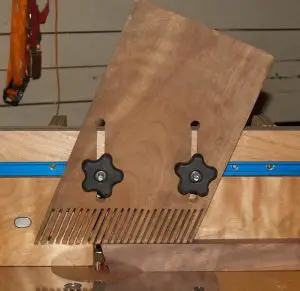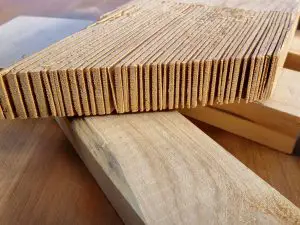Table of Contents
When working with wood, you want your project to turn out as best as possible. However, one of the most important things is that the project can be made safely and easily. Your woodworking tools will provide you with most of what you need but having additional accessories can vastly improve how easily and safely you use these tools.
A featherboard is a great example of this. While you can purchase them, it is also entirely possible to make your own, even out of scrap or reclaimed wood, saving you money and giving you a nice mini-project to get your teeth into.
What Is A Featherboard?

A featherboard is a piece of stock that features a solid side and a side with ‘fingers’, which is why you may also hear these accessories being referred to as a fingerboard. They are used in woodworking to improve safety and accurate cutting.
Featherboards come in a variety of shapes and sizes, which you use will depend on the project you are working on.
So, what does a featherboard do?
When cutting wood with various different types of saw, the featherboard is placed along the side of the material, applying pressure to keep it in place. This holds the wood against the machine or fence, allowing for easier and safer cutting. In terms of safety, these are some of the most important accessories, especially when it comes to kickback. In many cases, this kickback is caused when the wood moves away from the fence. However, using a featherboard will help to prevent this. Moreover, since the featherboard will keep the material in place, this makes it much easier to achieve an accurate cut. When working with narrow material, this is even more essential.
How it works is that the board’s fingers are set at an angle which allows them to propel the piece forward without being influenced by the rearward force of the cutter. You fix your featherboard to the table slots on the machine, or alternatively, just clamp it to the table. If you are looking to apply downward pressure to the wood, you will need to clamp the featherboard to the fence.
Where Can You Use A Featherboard?
Featherboards are incredibly diverse pieces of equipment and once you have one, you will appreciate just how useful they can be in various situations. They are typically used with mitre saws, table saws and router tables but the type you use and size will vary depending on the situation.
There are many featherboards that are commercially available. However, we would always suggest making your own as you can adjust it to your liking in terms of size and making it fit for purpose.
Benefits Of Using A Featherboard
It is clear to see that using a featherboard will improve your woodworking safety and efficiency dramatically. Let’s take a brief look over just some of the benefits you will notice from using this handy accessory
Increased Accuracy
Without the wood moving around as you cut, you are able to achieve much greater accuracy when using a featherboard. They can be placed in various positions, whether this is to apply pressure from the sides or from above, giving them greater versatility.
What’s more, since the featherboard won’t need to worry about moving position over the course of a cut, this won’t affect the accuracy as it might as you reposition yourself.
Safety – How Does A Featherboard Protect You?
When using a featherboard, safety is instantly improved. You need to be able to control your stock but placing your fingers in the area that a featherboard sits would be incredibly dangerous. This is one of the main ways it will prevent an injury.
Moreover, since the featherboard holds the stock in place, you don’t need to worry about kickback. As we mentioned earlier, this typically occurs when the wood moves away from the fence but this won’t happen with a featherboard in place. The board will apply gentle pressure allowing the wood to move freely without the effect of rearward force. That said, it is important to keep in mind that a featherboard should not be a replacement for a riving knife.
Repeatable Cuts
Having a featherboard in place means that you will be able to make repeated cuts with much greater accuracy. All you need to worry about is feeding the stock through the saw; provided the featherboard remains in the same place, you will achieve excellent consistency.
How To Make A Featherboard
If you’ve never made your own featherboard before, you could be forgiven for thinking that this was a trying task. But there really couldn’t be anything simpler. There are lots of creative ways that you might go about this, but we think that the following are the most simple.
Wood Offcuts

If you’re an avid woodworker then you will likely have a lot of scrap wood lying around. Don’t let this go to waste; there are several ways you can use this and one of them is for your DIY featherboard. Take the time to look through your scrap and choose a suitable piece.
You will now need to mark a line up to which the fingers will run. Typically speaking, this won’t need to be any more than around four or five inches. You don’t need to worry about being precise with the line, a rough mark will do just fine.
Next, you will need to set your mitre saw angle to cut the fingers. We find that setting it to around 30º works pretty well. You can now power up the saw and make the first cut. Before you move on to cutting the other fingers, you will need to secure the back rail of the saw using a clamp to ensure that you get an accurate repeat cut.
It is also important to make sure that your cuts are the right distance apart. If you cut the fingers more than half an inch wide, you will find that they don’t have the spring to be effective. However, you don’t want to make them too thin either; around a quarter of an inch should be just right.
Now, continue to make cuts along the entire length of the board. You will need to switch sides to make the last few so be mindful that this may feel a little odd and take your time. And there you have it…a quick and easy featherboard made from wood you already had lying around.
A great video showing how to make featherboards from wooden offcuts
Cheap Plastic Cutting Boards
If you don’t have any spare wood lying around then it is also possible to fashion a featherboard using a cheap plastic cutting board and you can use most wood cutting tools to cut plastic. These can be picked up from a variety of places, including the PoundShop; so if you’re not looking to break the bank, this is an incredibly affordable option.
As with wood, you will need to choose the right size. If the board is too large, you can always cut it down to size. If you are going to be making a particularly small featherboard, then it is a good idea to make a template to hold this in as you cut. You can do this by using some scrap wood.
You can use the same cutting technique as you did with the wood featherboard. Using a router table with a circle cutter will provide the most accurate cut. You will then need to drill holes in both the plastic board and a piece of wood, which will act as an extension on the feather board when it is needed. These holes will allow you to bolt the plastic and wood together and separate them as necessary. And when you are finished, you simply need to tidy up the edges.
A great video showing how to make featherboards from cheap cutting boards
Conclusion
A featherboard is one of the most essential workshop accessories for making woodworking safe and accurate. They can be purchased in various shapes and sizes but if you want greater control over the dimensions then making your own is the best option; not to mention, you’ll save a pretty penny.
All in all, this is a pretty cheap and easy project and something that you can knock up very quickly in the workshop. They are easy to batch out too, so you can make a few at a time, which is useful as they do tend to get damaged quickly.
As a cheap and easy project, making featherboards would be a project that I would recommend to the beginner or more experienced woodworker alike and the added safety of a featherboard makes this a no-brainer to do!

